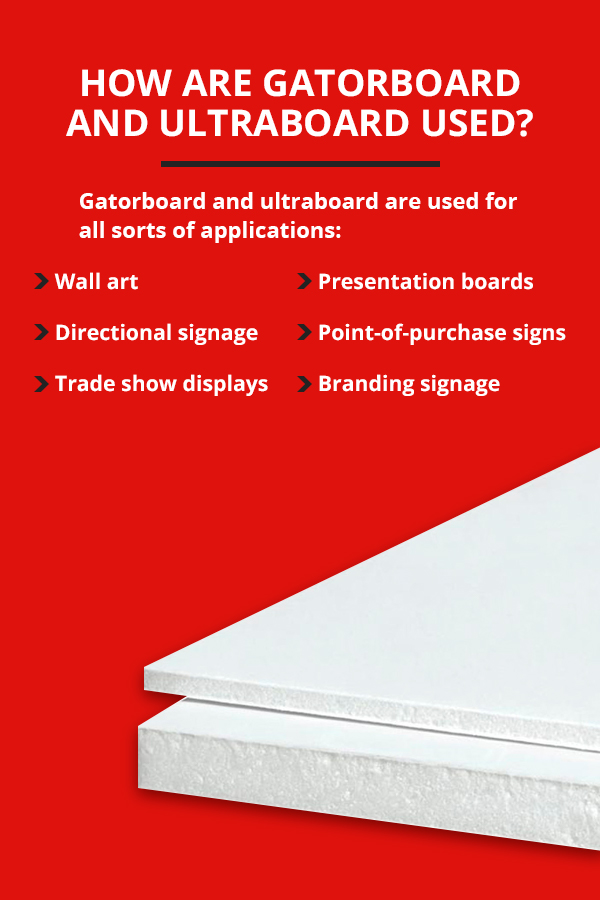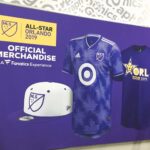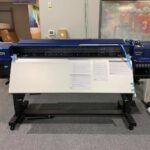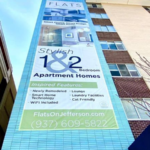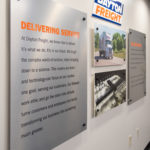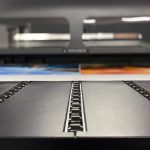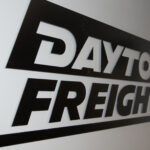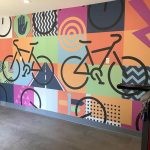With so many materials to choose from for signage and other displays, it can be hard to select the right canvas for showing off your graphics. If you’re looking for a durable and attractive sign material, consider gatorboard or ultraboard.
These materials are high-performance rigid substrates, comprised mainly of foam, that offer a wide range of possibilities for creating eye-catching signage and even works of art. SpeedPro studios have access to a variety of materials, including gatorboard and ultraboard, and the cutting-edge equipment to help you turn your custom graphics into striking displays that will stand the test of time.
WHAT ARE GATORBOARD AND ULTRABOARD?
Gatorboard and ultraboard are similar types of durable display boards. They’re both comprised of a dense foam interior that’s covered on the outside by a smooth substrate, which can be printed on. The composition of this outer finish is what sets gatorboard and ultraboard apart.
Gatorboard, also sometimes called gator foam, is covered in a thin veneer comprised of melamine and wood fiber. This veneer makes gatorboard very rigid, so it’s not prone to warping. Ultraboard is covered in a thick layer of polystyrene plastic. Unlike gatorboard, ultraboard has some flexibility.
Printers can either overlay these display boards with vinyl — either with or without lamination — or print on them digitally with a UV flatbed printer. Both gatorboard and ultraboard are durable, water-resistant surfaces, perfect for permanent indoor signs.
HOW DO GATORBOARD AND ULTRABOARD COMPARE?
We’ve already covered what sets these materials apart from each other, but how should you go about choosing between the two for a particular project? Let’s take a moment to discuss gatorboard vs. ultraboard so that you can make the best choice. These materials are very similar in terms of price, and they’re both intended for permanent use indoors, so you can’t go wrong either way. However, you may be better off to choose one over the other in some instances.
If strength is a key factor, choose ultraboard. Both materials are durable, but ultraboard is the stronger material of the two since it can flex under pressure. If you would rather have a more rigid material, go with gatorboard.
Another factor to consider is the finish. Since ultraboard has a plastic finish, it tends to have more of a sheen, whereas gatorboard will appear more matte.
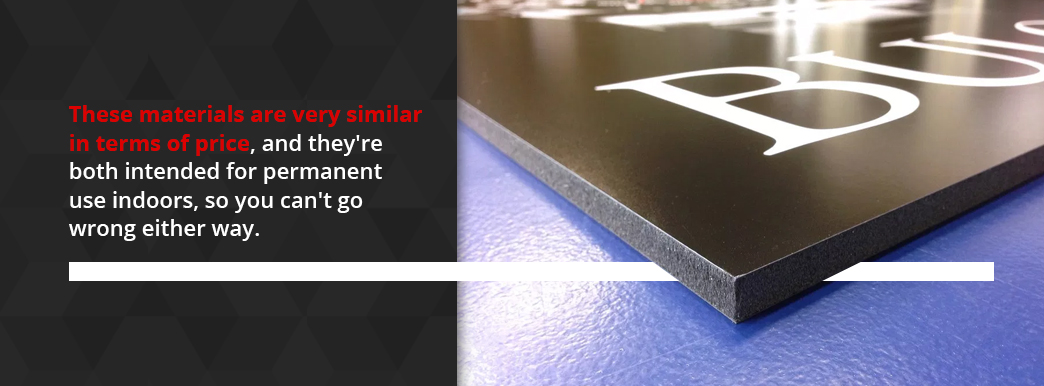
HOW DO THESE MATERIALS COMPARE TO FOAMCORE?
If you’re wondering about ultraboard and gatorboard vs. foam board, the answer is that all of these materials are similar since they’re primarily made up of a foam interior. The main difference is that foam board, also called foamcore, is covered in a thin layer of paper rather than a more durable surface. As a result, foamcore signs are subject to dents and scratches. You can print directly onto the surface of the board just as you can with ultraboard or gatorboard.
Foamcore is a good option to consider for more temporary sign installations since it costs less than gatorboard and ultraboard. However, when you want a higher quality option for a long-term display, gatorboard or ultraboard is a better choice.
ARE THERE OTHER RIGID SUBSTRATES TO CONSIDER?
You can choose from many other sign and display materials, including other rigid substrates. Each material comes with its own advantages and limitations. Here are a few other popular choices to consider:
- Aluminum: Aluminum is a popular material of choice for parking and traffic signs. It can also be suitable for some indoor signage, though it may have an industrial appearance.
- Acrylic: Acrylic is a hard material that resembles glass when it’s clear, though you can also choose from a variety of colors. It’s a more upscale product that’s especially valued for dimensional letter signage.
- Coroplast: This material costs less and is intended for more short-term signage. It’s a popular material for yard sale or sidewalk signs but isn’t a good choice for more long-term indoor applications.
- MDO: MDO stands for medium density overlay. This material is an engineered plywood panel finished with resin-covered paper. It’s intended for outdoor use.
- PVC: Also called Sintra board, PVC offers many of the same benefits as gatorboard and ultraboard. One advantage it has is that it comes in more color options. However, it weighs a bit more.
HOW CAN YOU CUSTOMIZE YOUR GATORBOARD/ULTRABOARD DISPLAY?
When you choose to print on either ultraboard or gatorboard, you can further customize your material selection in a few ways, including:
- Color: Gatorboard and ultraboard typically come in solid black or white, though you may also be able to get a combination where the center is black and the overlay is white. If you choose a black board, you’ll need to print on it with vinyl or white ink.
- Thickness: You can also select a thickness to fit the look and level of quality you’re aiming for. Some common thicknesses are 3/16 of an inch, 1/2 an inch and 1 inch.
- Size: Ultraboard and gatorboard typically come in 4-by-8- and 5-by-10-foot sheets. You can also cut these display boards to fit a custom set of dimensions or even a unique shape. Some people use ultraboard or gatorboard for custom-cut letters and other shapes.
- Graphics: Of course, you’ll also get to customize your display board with your custom graphics. You can include eye-catching images and text that help you get your message across, whether it’s for marketing, wayfinding or any other purpose.
WHAT ARE THE BENEFITS OF GATORBOARD/ULTRABOARD?
Gatorboard and ultraboard are excellent materials to choose for a wide variety of projects. They offer some valuable advantages that can make them the best option in many cases. These materials are:
- Lightweight: One advantage of these materials is that they don’t weigh much, which makes them easy to install. You can even hang them from a drop ceiling without worrying about the weight pulling them down. Their lightness also makes them easy to transport, which is an important advantage for event marketing. Imagine the struggle of transporting heavy displays to your trade show venue and then trying to set them up. The lighter a sign is, the easier it tends to be to work with it.
- Sturdy: Despite how lightweight these materials are, they’re also very sturdy, unlike many other lightweight materials. People often use foamcore, gatorboard or ultraboard to mount photo or paper displays because it’s a rigid material perfect for backing. Printing directly onto these materials is a simpler means of achieving the same stable display. Since these materials are exceptionally sturdy and hold their shape, you can display them in a variety of ways, including on easels or other stands.
- Versatile: Gatorboard and ultraboard are very versatile materials. They can be used for all sorts of purposes in a variety of environments. You can customize your display board with your personalized graphics, choose the specifications you like in terms of thickness and size and even cut out custom shapes. When you work with ultraboard or gatorboard, you won’t be limited by anything aside from your imagination. We’ll talk more about possible ways to use these materials below.
- Cost-effective: Ultraboard and gatorboard cost more than materials engineered for more short-term use, such as foamcore. However, they’re still affordable materials and even cost less than some other rigid sign materials. They’re especially cost-effective when you consider their ability to resist wear and last as permanent or semi-permanent installations. You may save money upfront by choosing a lower cost material, but if you need that sign or display to last, you’ll find yourself purchasing a replacement after a bit of time has passed.
- Durable: One of the greatest benefits of these materials is how durable they are. Their hard surface, whether wood veneer or plastic, resists any type of typical damage that may befall other kinds of signage. The list includes dents, scratches and even water damage. Durability is especially important if you plan to take your displays with you to events, such as trade shows. You don’t want to pack your displays and arrive at your booth only to find that they appear beat up. Fortunately, you won’t have to worry about that with gatorboard or ultraboard.
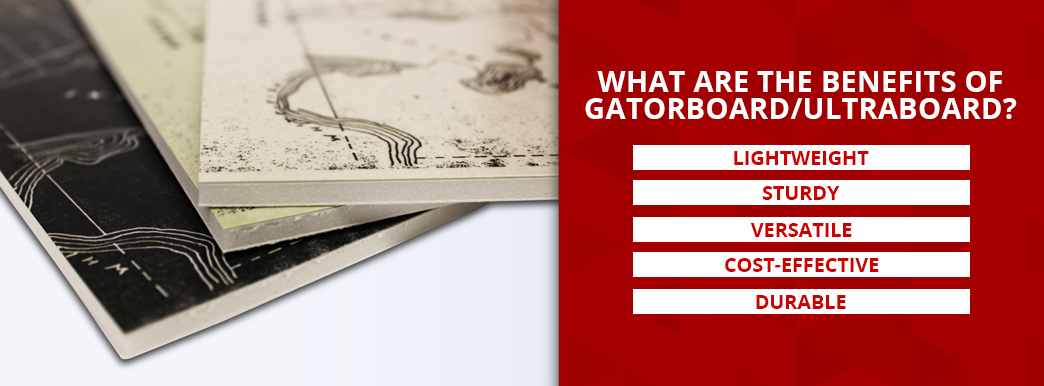
ARE THERE ANY DOWNSIDES TO ULTRABOARD OR GATORBOARD SIGNAGE?
When you’re choosing a material for your project, you may also want to know whether there are any reasons to pass on a possible option. In the case of gatorboard and ultraboard, there are just three possible downsides to consider, and it really comes down to your intended application. These materials are not the best choice for:
- Outdoor use: One limitation of gatorboard and ultraboard is that these materials are not intended for outdoor use. Despite their water-resistance and overall durability, they’re not designed to stand up to the elements long-term. That said, signs made of gatorboard or ultraboard are perfectly suitable for outdoor events as long as the weather is fair or they’re covered.
- Short-term use: Gatorboard and ultraboard work well for just about any type of indoor signage, including temporary signs. However, in the case of temporary signs, especially for one-time use, you can save money by choosing plain foamcore or a similar material. Since gatorboard and ultraboard are made to last, they may not be the best choice for short-term use.
- Museum use: A third instance in which ultraboard and gatorboard are not a good choice is in environments where they’ll be in contact with artifacts or works of art that could be damaged by the acid if kept in contact long-term. For example, these materials would not work as matting on a painting or as a label that touches an artifact.
HOW ARE GATORBOARD AND ULTRABOARD USED?
Gatorboard and ultraboard are used for all sorts of applications. Typically, these applications involve long-term use rather than temporary use. Let’s take a look at a few below:
- Wall art: Individuals and businesses alike enjoy artwork on their walls. Art can brighten up a space and make it a more enjoyable and even more productive environment. Gatorboard and ultraboard are perfect materials for custom wall art of any kind. You can print a favorite photo or custom graphics that will help you define your space. You can also choose to frame your print or leave it since it’s a sturdy material on its own.
- Directional signage: In public places, such as offices, hospitals, hotels, restaurants and more, directional signage is essential. Also called wayfinding signage, directional signs help people navigate a physical space. They may indicate that restrooms are to the left or that you’ve arrived at the main conference room. Ultraboard and gatorboard are both great choices for directional signs since they’re made to last.
- Trade show displays: We’ve already mentioned some of the benefits of gatorboard and ultraboard that make these materials smart choices for trade show exhibitors, including their durability and low weight. Ultraboard and gatorboard are great for trade show displays, regardless of whether you just want to get your branding out there or achieve a more specific goal.
- Presentation boards: Presentation boards are visual aids that speakers use to help illustrate research or the highlights of their presentation. They can be used in either educational or business settings. Ultraboard and gatorboard are excellent choices for creating a professional-grade presentation board, especially if you plan to use it repeatedly.
- Point-of-purchase signs: Point-of-purchase displays, commonly shortened to POP displays, are one of the most popular uses for gatorboard and ultraboard. These signs are positioned near the checkout area and aimed at customers who are already planning to make a purchase, so they may be intended to develop greater brand loyalty or encourage the person to make impulse buys.
- Branding signage: Branding is a crucial aspect of any business. Some signs in your place of business should be dedicated to showing off your logo or other aspects of your branding. Ultraboard and gatorboard are perfect materials for displaying your logo, especially if you want to create a dimensional letter product. Opt for a thicker size for an especially impressive effect.
